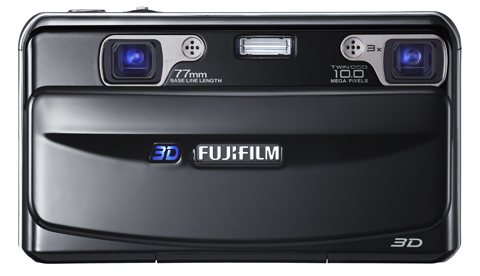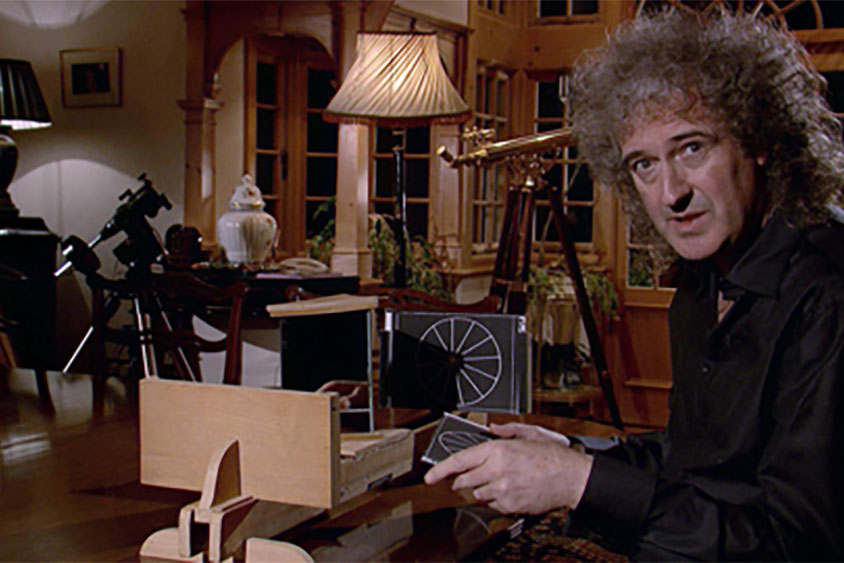Queen days
Queen legend Brian May talks about his passion for 3D, a new photography project and a hankering for the traditional darkroom in this interview with Amateur Photographer news editor Chris Cheesman…
 Brian May (left) on stage with fellow Queen band member Freddie Mercury, at Knebworth in August 1986
Brian May (left) on stage with fellow Queen band member Freddie Mercury, at Knebworth in August 1986
Picture credit: Redferns
Brian May’s enduring rock star status is signalled by the trademark hair and PR girls aplenty buzzing around the lobby of a swanky hotel in Soho.
Armed with a PhD in astrophysics, the lead guitarist for a band reputed to have sold 300 million albums is, though, disarmingly grounded on first meeting.
Brian May CBE is also reassuringly open, not a trait he associates with the stereoscopic clubs of this world which, he concedes, are akin to a ‘kind of secret society?.
Not that he minds. Like an obsessed fan with the best seat in a highly specialised arena, this unabashed 3D disciple seems to revel in his role as the public face of stereoscopic photography.
May’s lust for the third dimension began as a boy when he collected stereo cards given away free with packets of Weetabix cereal.
?This is a passion I have had for most of my life? The first time I saw the magic I was completely transported,? he remembers.
Seeking out like-minded enthusiasts, May first joined the Stereoscopic Society around 40 years ago where he pursued an interest in 35mm format stereo slides.
And the 3D flame has remained undimmed ever since – emerging unscathed from tours with Queen during the 1970s and 1980s when, the morning after the night before, he would scour dealers for new stereoscopic treasures.
?I always carried a stereo camera with me in the Queen days,? he says, insisting his hobby was not simply a release from the rigours of life on the road.
?It was just a twin path. No, I never got bored on tour and I never got to the point where I wanted to get away,? he reflects.
?It was purely ?here is another great passion? and something which I could follow in a way no-one else could I suppose.
?I was able to travel the world because of Queen, and what was going on, and so I had access to people who were interested in my hobby, if you like, all round the world.?
So, did fellow band members Freddie Mercury, Roger Taylor and John Deacon share May’s fascination for 3D? ?They did enjoy it, yes. I showed them quite a few things when I was collecting,? he recalls.
?Obviously they didn?t get obsessed like me but they liked it, yes, absolutely.
?Freddie was kind of obsessed with his Polaroid camera when he first got it.
?He loved the fact you could take a picture and you could see it immediately, so he was taking all his friends and enjoying the moment.?
Little black book
The globetrotting songwriter would log details of the stereo dealers, fellow enthusiasts and collectors he met along the way, in his ?little black book?.
?I think I still have it somewhere. It?s a bit out of date now but some of those people I keep up with. It?s been rather nice.?
As a renowned collector he has amassed ‘tens of thousands’ of stereoscopic cards ? and he is not done yet, though the rate has slowed in recent years.
?I?ve been to a lot of auctions in my time… and, of course, you can buy them hundreds at a time, particularly the 1900s ones which are my speciality??
Many of the 19th century stereo cards, he explains, were created from scenes captured in Britain, and ?tell a story?. And around the turn of the century you could buy them in box-sets.
?You had landscapes, portraits and there was a very big business for people making what became known as ?sentimental stereo cards???
Fast forward to 2011 and a screening room inside the W Hotel, just off Leicester Square.
May is back in the spotlight to publicise a one-hour documentary for Sky TV called Brian May?s Brief History of 3D.
In the programme, to be broadcast on 7 July, May explains how the stereo image became popular in the 1850s ? largely thanks to the discovery of modern photography that followed Charles Wheatstone?s invention of a stereoscopic viewer in 1838.
After Louis Daguerre and Henry Fox Talbot revealed their respective photographic processes in 1839, photographers were despatched far and wide to capture scenes that could be made into stereoscopic cards.
By 1858 – at the height of the 3D craze – the London Stereoscopic Company reportedly had more than 100,000 pictures for sale and a New York manufacturer claimed to be churning out 23,000 a day.
But the format?s popularity waned in the late 1860s and 1870s, not helped by photographers such as Eadweard Muybridge whose interest veered towards the moving image.
BRIAN MAY INTERVIEW CONTINUES HERE
Talks with Fujifilm
Talks with Fujifilm
After several false starts the world of 3D has now entered its next crucial phase, far removed from the Victorian contraption that first gave the viewer an optical illusion of depth by presenting slightly different images to each eye.
For his part, May is keen not to miss out on the next chapter in the 3D story. Initially sceptical about the advent of 3D television he has now fully embraced it.
?I got a 3D TV a couple of months ago and I?ve been completely glued,’ he enthuses.

May is also a fully paid-up fan of Fujifilm?s 3D digital stills camera. Released in 2009, the FinePix Real 3D W1 enables the user to view the three-dimensional image on the camera?s built-in screen, without the need to wear special glasses, an aspect that appeals to this 3D aficionado.
?It?s magical. I love it. It?s a wonderful toy at the very least. Everyone I show it to wants one.?
The image quality, he asserts, is ?just about good enough, if you are careful?, to make some decent 3D slides for the ?owl? stereo viewer May designed to go with a book on 3D photography, published two years ago.
?You can put any of the classic stereo cards in there, daguerreotypes, slides ? and I can make something similar to that from the Fuji camera.?
May has even tried to persuade Fuji to produce – with his input – stereo cards for the mass market.
So far, though, this particular project has yet to move on to the next dimension.
?We are still talking,? he stresses and is hopeful other camera makers will see fit to follow Fuji?s lead in the 3D camera market.
Perched ?on the brink?
Perhaps 3D digital stills cameras can wait to catch on, but how long before 3D television ignites the passion of a mass audience?
Huge investment in 3D from the likes of Sony and Panasonic suggest it is more than a gimmick, but May is reluctant to predict its long-term future as a technology for the masses.
?There?s a whole community of people who have carried a torch for 3D over the years and I think we are all looking around us in slight amazement at the fact that 3D has become the watchword on everybody?s lips now? because of Avatar [the 3D movie], Toy Story 3 and all the things that are going on.
?We are definitely hoping it?s here to stay.?
However, he cautions: ?I think it?s still perched on the brink. A lot depends on how the quality is controlled.
?If people get pissed of with it, because of eye strain or whatever – which tended to happen in the past when we weren?t clever enough – then it could still take a dive.?
Key to its success in the TV format, he agrees, will be the ability to dispense with 3D glasses.
?I think that will be a major milestone because the glasses are a bit of pain in the neck. It will be great if we get to the point where glasses-less TV really works.
?In the cinema, people are quite happy to wear something on their face for a couple of hours but, around the house, it will make a huge difference.?
?Element of Escapism?
Even if 3D TV fails to set the world?s living rooms alight, the choice between a 2D or 3D still image is a no-brainer as far as May is concerned.
?The stereoscopic image has an enormous amount more to connect with you, whether you look at it immediately, or in a few years time. It?s incredible what it does to you,’ he tell us.
?For instance, I took stereoscopic images of my kids when they were growing up. You look at these images in my stereo realist viewer now and it?s uncanny ? you really see them as they were and can almost talk to them.?
May accepts ?there is an element of escapism? in looking at images through a 3D viewer, but says it is more about the ?realism? that the format delivers.
?You?re taking a photograph because you want a representation of a moment in your life and most people take a very strange flat representation, which really has very little to do with the event itself.?
Given his unrelenting thirst for 3D in all its forms – coupled with a penchant for exposing a forgotten past – what?s next?
A new book it seems, along the lines of A Village Lost and Found, a book May co-authored in 2009 with photo historian Elena Vidal.
The pair embarked on a mission to track down stereoscopic cards created by Victorian photographer TR Williams and identify the village they relate to ? Hinton Waldrist in Oxfordshire, as it turned out.
For his next trick, May is working with French and American researchers to shed light on a relatively unknown series of French stereo cards from the 1860s, called Les Diableries.
?They feature a variety of devils, skeletons and ghouls.. a fascinating series, the whole French tissue??
French tissues, he explains to an intrigued and somewhat relieved listener, feature a print on a piece of photographic paper, with colours painted on the back. The viewer only sees colour when the image is held up to the light.
?So there?s a magical transformation between what appears to be a daylight view? and a night-time view when you hold it up to the light.?
What?s more, red gels are used for the devils? eyes, making them leap out in a ?mysterious and threatening way?.
?They are also fascinating because they give a complete parody of life in 1860s France ? very satirical.?
The origin of many of these cards – of which there are believed to have been just 72 – remains a mystery.
That could be about to change. ?There are very few collectors who appreciate these things and pursue them.
‘We will be uncovering the origin of these wonderful pictures.?
BRIAN MAY INTERVIEW CONTINUES HERE
Analogue rocks
Analogue rocks
May?s zeal for imaging stretches back to the time he spent in his father?s darkroom.
?I was lucky enough to have a dad who spent hours and hours with me in the darkroom, developing our own pictures and printing them.
?I have a great love for photography, mostly the processes that were around when I was a kid, the films, the gaslight paper and the bromide paper and all that stuff, the smell of the chemicals? it will always be with me.?
He clearly still has a hankering for the darkroom and relishes the challenge of exploring processes from a bygone era – his personal ?voyage of discovery?.
To that end he recently commandeered ?the best wet plate practitioners of the present day? in a bid to re-create the conditions under which Victorian photographer TR Williams would have worked.
May’s latest mission involved the wet-plate collodion process and similarly antiquated darkroom techniques that brought him into contact with ?all sorts of horrible chemicals?.
Yet, perhaps like searching for a long lost vinyl record in a world awash with iTunes downloads, such ventures can be worth the journey.
?There are magical things you can get with those old analogue processes which you have to work very hard to get in the digital domain… a bit like with sound,’ adds the award-winning composer who is back on stage after sell-out dates at the Royal Albert Hall.
?I still have a great fondness for all the analogue recording techniques – and we still use them in this world of digital.?
Brian May’s Brief History of 3D will be screened on Sky 3D on 7 July








